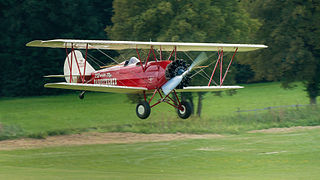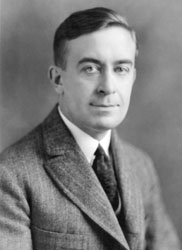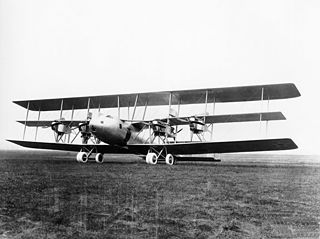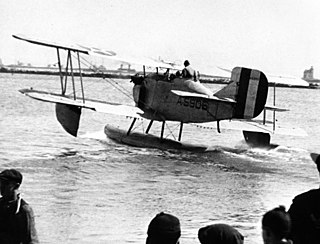Related Research Articles
The Aircraft Manufacturing Company Limited (Airco) was an early British aircraft manufacturer. Established during 1912, it grew rapidly during the First World War, referring to itself as the largest aircraft company in the world by 1918.

The Curtiss JN-4 "Jenny" was one of a series of "JN" biplanes built by the Curtiss Aeroplane Company of Hammondsport, New York, later the Curtiss Aeroplane and Motor Company. Although the Curtiss JN series was originally produced as a training aircraft for the US Army, the "Jenny" continued after World War I as a civil aircraft, as it became the "backbone of American postwar [civil] aviation."

Curtiss Aeroplane and Motor Company was an American aircraft manufacturer formed in 1916 by Glenn Hammond Curtiss. After significant commercial success in the 'teens and 20s, it merged with the Wright Aeronautical in 1929 to form Curtiss-Wright Corporation.

The ERCO Ercoupe is an American low-wing monoplane aircraft that was first flown in 1937. It was first manufactured by the Engineering and Research Corporation (ERCO) shortly before World War II; several other manufacturers continued its production after the war. The final model, the Mooney M-10, first flew in 1968 and the last model year was 1970. It was designed to be the safest fixed-wing aircraft that aerospace engineering could provide at the time and the type continues to enjoy a faithful following.

Huff-Daland was an American aircraft manufacturer. Formed as Ogdensburg Aeroway Corp in 1920 in Ogdensburg, New York by Thomas Huff and Elliot Daland, its name was quickly changed to Huff-Daland Aero Corp and then in 1925 it was changed again to Huff-Daland Aero Company with its main headquarters in Bristol, Pennsylvania. Huff-Daland produced a series of biplanes as trainers, observation planes, and light bombers for the U.S. Army and Navy.

The Waco Aircraft Company (WACO) was an aircraft manufacturer located in Troy, Ohio, United States. Between 1920 and 1947, the company produced a wide range of civilian biplanes.

Monocoupe Aircraft is a type of small light airplanes originally produced in the late 1920s and 30s. The company was famous for introducing relatively inexpensive, compact, convenient, sporty, and efficient flying to the light plane market. In an era of large, expensive, open-cockpit biplanes, the Monocoupe was the first popular, compact, enclosed-cabin, two-seat, light plane in the United States. As a result, the Monocoupe soon became one of the most popular and successful brands of airplanes in American air races of the 1920s and 1930s.

The Travel Air 2000/3000/4000 (originally, the Model A, Model B and Model BH were open-cockpit biplane aircraft produced in the United States in the late 1920s by the Travel Air Manufacturing Company. During the period from 1924–1929, Travel Air produced more aircraft than any other American manufacturer, including over 1,000 biplanes. While an exact number is almost impossible to ascertain due to the number of conversions and rebuilds, some estimates for Travel Air as a whole range from 1,200 to nearly 2,000 aircraft.

Alfred Victor Verville was an aviation pioneer and aircraft designer who contributed to civilian and military aviation. During his forty-seven years in the aviation industry, he was responsible for the design and development of nearly twenty commercial and military airplanes. Verville is known for designing flying boats, military racing airplanes, and a series of commercial cabin airplanes. His planes were awarded with the Pulitzer Speed Classic Trophy in 1920 and 1924.
The Boeing Model 203 was a three-seat biplane trainer build by Boeing in the late 1920s and used in the company training school.

The Waco 9 is an American-built three-seat biplane design that first flew in 1925.

The Swallow Airplane Swallow is an American-built general purpose biplane of the mid to late 1920s.

The Wittemann-Lewis Aircraft Company was an American aircraft manufacturer between 1906 and 1923. It was notable for building two large aircraft, the Sundstedt-Hannevig transatlantic seaplane with a 100-foot wingspan and the NBL-1 Barling Bomber a six-engined triplane with a 120-foot wingspan.

Albin Kasper Longren was an American aviation pioneer from the state of Kansas. Beginning in 1911, Longren successfully flew airplanes of his own design and construction. Fully self-taught as an aircraft designer and pilot, he built a thriving career as a barnstormer with his own craft, becoming known throughout the Midwest as the "Birdman".

G Elias & Brother was and American manufacturer of cabinets and aircraft based in Buffalo, New York in the 1920s. A.G. Elias sat on the Manufacturers Aircraft Association's board of directors along with President Frank H. Russell, VP Glenn L. Martin, Charles L. Laurence, Chance M. Vought, S.S. Bradley, George P. Tidmarsh, and Donald Douglas. E.J Elias promoted the construction of a Buffalo municipal airport to aid the local fledgling airplane industry of five aviation companies constructing airplanes and airplane parts. From 1920 to 1925, Elias company's chief engineer, David Earle Dunlap (1896-1957), designed the Elias EM-2 Expeditionary planes. He designed the NBS-3 bomber fuselage and the Elias M-1 Mail plane. Dunlap's Elias TA-1 design was the first United States Army Air Corps Trainer to have a radial engine. After tests a McCook Field, the Army Air Corps selected other manufacturers over the Elias bomber and trainer. The company designed the Elias EM-1 to meet requirements for a multirole amphibian marine expeditionary aircraft. Elias delivered six production Elias EM-2 aircraft with Liberty engines to the United States Navy in 1922.
References
- 1 2 3 "American airplanes: Lo – Lu". Aerofiles.com. Aerofiles. 2008. Retrieved January 26, 2016.
- 1 2 3 Lambertson, Giles (July 22, 2015). "The Birdman of Topeka". Air & Space . Smithsonian. Retrieved February 4, 2016.
- ↑ Staff writer(s) (April 14, 1959). "Other Sales, Mergers". The New York Times. New York. AP . Retrieved January 23, 2016.